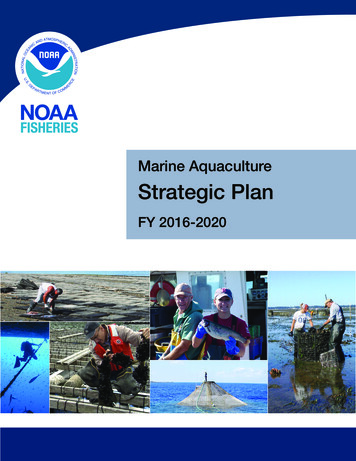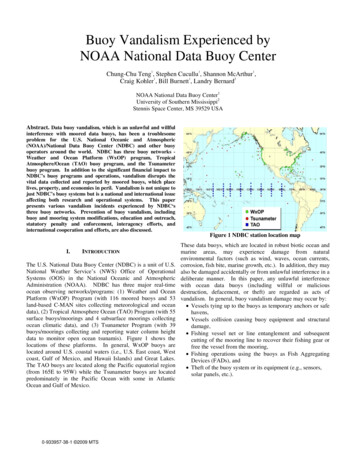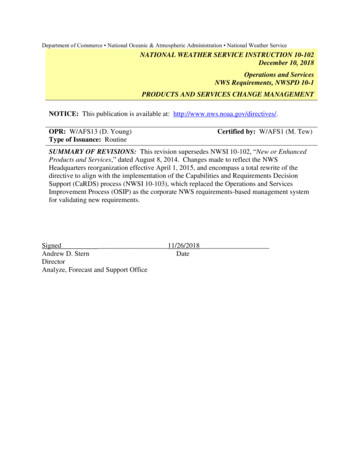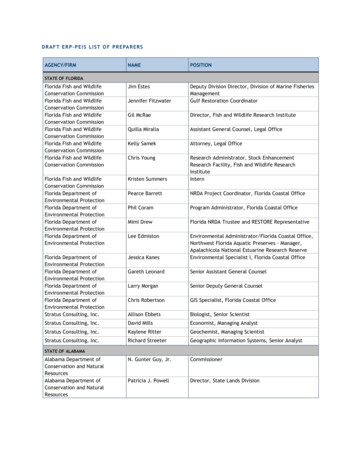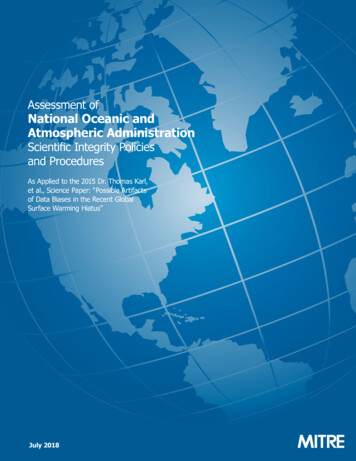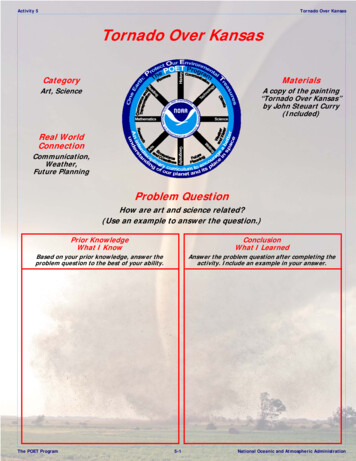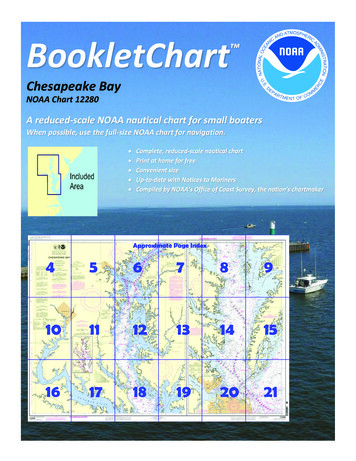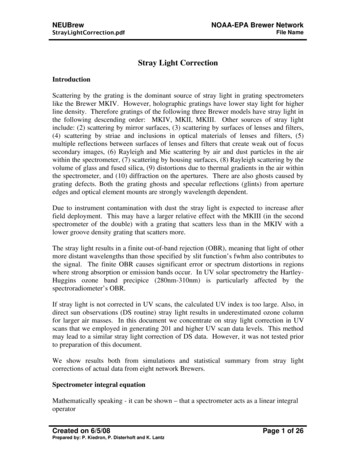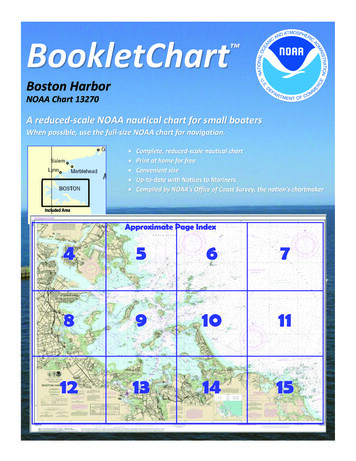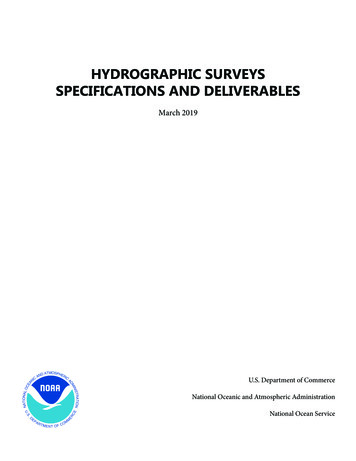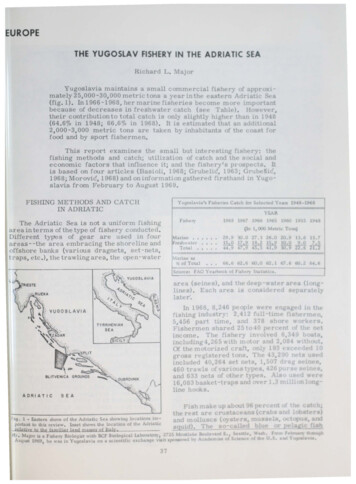
Transcription
EUROPETHE YUGOSLAV FISHERY IN THE ADRIATIC SEARichard L. MajorThis report examines the small but intI Il'stIng fish r :fishing methods and catch; utilization of catch and thoclal andeconomic factors that influence it ; and th fish ryls pI' sp ct . Itis based on four articles (Basi oli, 1968; Grub he, 1963; rub Ie,1968 ; Morovie, 1968) and on information gather d firsthand In Yu 0slavia from February to August 1969.F ISHING METHODS AND CATCHIN ADRIAT ICThe Adriatic Sea is not a uniform fishingarea in t erms of the type of fishery conduct d.Diffe r nt types of gear are used in fourareas--the area embracing the shoreline andoffs h ore banks (various dragn ts, set -nets,traps, tc .), the trawling area, the open-waterADRIATICS EA37FIShery(1arine re w t r Tout .29.915 . 044.,0
38(such as sardine. sprat. anchovy. and mackerel) compose about thr e -fourths th commercial catch. About 85 percent of thes blufish are canned; the rest are salted or consumed fresh.Shoreline and Bank AreaThis area includes the waters adjacent tothe mainland of Yugoslavia. the islands. andthe reefs. It makes up only one -thirtieth ofthe eastern half of the Adriatic (th otherhalf is adjacent to Italy) but yields one -fifththe catch. It is by far the most varied regionin number of species caught. The dominantfishes are: picarel (Maena spp .). grey mullet(Mugil spp.). dentex (Dentex spp.), bream(Sparidae), pandora (Pagellus erythrinus) ,salema (Boops salpa). bogue (Boops boops).greater amberjack (Seriola dumerili). leerfish (Lichia amia), wrasse (Labridae). bass(Dicentrarchus labrax). scorpioniish (Scorpaena spp.). corb (Umbrina cirrosa), brownmeagre (Corvina nigra). red mullet (Mullusbarbatu . striped mullet (Mullus surmuletus),forkbeard (Phycis phycis). comber (Serranusspp.). grouper (Epinephelus ). moray(Muraenahelena), conger eel (Conger conger),gar-fish (Belone belone), blue damsel fish(Chromis chromis), goby (Gobius spp.). andsmelt (Atherine spp.). Also important arethe following invertebrates: octopus (OctopusvulgariS), common squid (Loligo vulgariS),cuttlefish (Sepia officinalis), spiny lobster(Palinurus vulgaris), lobster (Homarus vulgaris), spider crab (Maja sJuinado), commonprawn (Palaemon serratus. oyster (Ostreaedulis), mussel (Mytilus galloprovincialis),and date -shell (Lithophaga lithophaga).*This area offers the most favorable con ditions for effective year-round fishing: accessibility. shallow water. and high -qualityfish. It is not surprising, therefore. thatthese grounds have been exploited for thousands of years.Fig. 2 - Dalmatian fisherman preparing basket-t ra ps .These traps are widely used in Yugoslavia for takingfish and shellfish.Fishingmostlyspears,in theirwith basket - traps (fig . 2) is donl by islanders, who also use hookSgillnets. drag-nets. and beam trawlssubsistence fishery .jThe subsistence fishery is the bigge.single element of the coastal fishery todaIt involves thousands of fisher men - -at leala few from every community. Nearly eve household has a few fish dinners weekIIz Veli, a typical island community, is ShO lin figure 3.Sp ort Fi shingThe coastal fishery is a mosaic of different types of gear. Most numerous are ny longillnets. various drag-nets (set from smallboats. then retrieved byhand from the beach),and small beam trawls. In recent y ears. theuse of drag-nets has been greatly curtailedbecause of the convictionthat this gear takestoo many immature fish. As drag-nets arephased out. gillnets t end to replace them.Sport fishing is increasing. In 1962, ove r5.000 members were registered in 52 clubSThe number of unregistered sport fisherme!was estimated to be twice that large. Thes f ish e r men used about 6,000 skiffs, 1, 50(underwater spear-guns. 2,500 gillnets, ane300.000 longline hooks. One concerned scien'tist calculated, on the basis of 1962 stati sti *All scientific and most common names are from Bini (1965). Where common names familiar to U.S. and Can a d ian readellwere needed, the names recommended by the American Fisheries Society (1960) were used.
39Fig. 3 - The village of lz Veli on the island of the same name--a typic al island fishing village of Yugoslavia .data, that e ach square kilometer in the coastala.re a had 11 fishermen (professional, subsistence' and sport), 4.6 boats, 12.7 nets, 5 bas(e t-traps, and 1.5 longlines . These figuresE d not include large numbers of unregistered) m all nets - -especially gillnets. The intensity)f sport fishing has probably increased sev r al fold since the s e calculations were made. ynamite is now wide l y (but illegally ) used to[[11 fish.These data attest the heavy exploitati onCatch statistics show,'llr thermore, that some of the most valuablei:?ecies, red mullet, striped mullet, dentex, , a ss, bream, scorpionfish, and octopus, area r less abundant today than 100 or: even 50[Icars ago. Less desirable species, such asJOgue and other small fishes, make up an incr eaSing percentage of the catc h. The youngof most important species have legal protec:ion--aminimum body length regulation. The egulation is difficult to enforce, however, andseems largely ineffective.n the coastal zone.r rawling AreaThis area extending out to depths of 300ne ters (the limit for standard Adriatic trawl r s) ranks second in size and in the number)f species taken. Important are hake (Mer -luccius merluccius), skate (Raj a sPP.), sole(Solea spp.), anglerfish (Lophius spp.), gurnard (Trigla spp.), whiting and poor cod(Gadus spp.), John Dory (Zeus faber). dogfish(Sgualus spp., Scyliorhinus spp.), smoothhound (Mustelus spp.), angel shark (Sguatinaspp.), stingray (Dasyatis spp.), picarel, pandora, bream, weever (Trachinus spp.), argentine (Arge ntina sphyarena), squid, cuttlefish,Norway lobster (Nephrops norvegicus), andspider crab. There are large but as yet unmarketable populations of fan mussel (Pinnanobilis), s e a urchin (Echinus spp.), starfish(Antedon mediterranea), and sponge (Ge odiaspp., Mycale spp.).The history of exploitation in the t r awlingarea dates to the third and fourth centuryB.C., when the Greeks had colonie s on thepresent -day Yugoslav coast. Ancient Greekdocuments show that longlines were used totake fish (chiefly hake, dogfish, and skate) inwater down to 100 meters. Trawling withtwo-boat com bin at ion s (pair trawling) indepths to 80 meters began about 200 yearsago. Motorized vessels were first used inthese pair trawling operations in 1908; modern trawling (with doors) began just afterWorld War I. The number of boats in thetrawl fishery has fallen in recent y ears (from154 in 1961 to 117 in 1965) .
40Only about one of every six boats is afull-time trawler. The others divide theirfishing time between trawling and other typesof fishing--chiefly seining for pelagic fish.The full-time trawlers are smaller vessels(under 100 hp.) built between the two worldwars. They operate in the canals between thelarger islands but, even there, they are oftenblownintoport by adverse winds and so average only about 150 fishing days per year . Ofthe larger boats (over 100 hp.) that dividetheir fishing time between trawling and othertypes of fishing, only every tenth boat fishesintensively in the open sea areas. The othersfish either inside or outside, but not extensively. Crews range from seven to eightmen for the larger vessels, upward fro m25 m., but are five or less for the smallerboats working in the canals.Trawlers now take 1,000 -1,600 metric tonsannually. The main t raw lin g area is theBlitvenica grounds (fig. 1). By agreement,part of this area is allocated to Italian fishermen. The Yugoslavs are reexamining thisagreement, however, in light of their own declining catches. (For details, see CFR, July1969, page 47.)Open-Water AreaAlthough this area is by far the largest interms of sea surface, scarcely one -half of itcontains Significant fish populations. Furthermore, fish in that one-half are not uniformly distributed: they are fairly abundanton some grounds but scarce in others.Of the about 200 commercially importantspecies in the Adriatic, only about 14 arefound in the open-water area. Yet this smallnumber makes up three-quarters of the com mercial catch. Important species are: sar dine (Sardina pilchardus), s p rat (Clupeasprattus), anchovy (Engraulis encrasicholus ),Atlantic mackerel (Scomber scombrus), chubmackerel (Scomber japonicus colias), Atlanticsaury (Scomberesox saurus), gar-fish, horsemac k ere I (Trachurus spp.), bluefin tuna(Thunnus thynnus), Atlantic bonito (Sardasarda), frigate mackerel (Auxis bisus), littletuna (Euthynnus alletteratuS). s w 0 r d f ish(Ziphias gladius), and bogue. These are allschooling fish--some dwell close and othersfar from shore. A catch of Atlantic mackerel,a popular fish cooked on a grill, is shown infigure 4.FIg. 4 - Atlantic mackerel, a popularfish, especially when cookedon a grill.The exploitation of pelagic fish in the Adriatic Sea is centuries old and spans three distinct periods . During the first, before 1929,the fishery was limited to a narrow band nearthe shore and involved only drag-nets and setnets. In 1929, the advent of purse seinesenabled the fishermen to move farther offshore. The first use of modern fish -detectione qui p men t and radio-telephones in 1953marked a beginning of the third period--expansion into previously unexploited areas.In 1968,416 boats were engaged in seining.These were two basic types . The first , about170 boats, operated by true professional fishermen' is typically 16-19 (occasionally 20-25)meters long with 80-150 (occasionally 150240) hp. (fig. 5). Nylon nets used are on theaverage 350 m . long, 80 m . deep, and arelifted with a winch. The average crew i sabout nine; the average yearly catch 90-100metric tons.Another type of seiner (246 boats) fisheScloser to shore, with cotton netting that requires much more maintenance than nylonets. These boats often fish on stations inarrow local areas where fish are known tcoccur. Crews are made up of seasonal workers who otherwise work at agricultural jobs;the crews are often twice as large as thoseof true professional seiners. The averagecatch is 25 -30 metric tons a year. Somebeach seines are still used for catching pelagic fish but in decreasing numbers. Special skiffs, outfitted with lights to attract fishschools, are an important part of the pelagicfishing (fig. 6).
41Fig . 5 - Three large purse seiners lying in port.The vessels are the backbone of the Yugoslav fishery for pelagic species.The fishing season lasts 9 months and isconfined to areas less than 120 meters deep.Beyond that depth only a rare school of Atl antic saury or tuna are found - -never sardines. The catch of pelagic fish has increasedsteadily from about 9 thousand metric tons in1955 to 23 thousand tons in 1968; sardinesmake up 54 percent, mackerel 13.5 percent,sprat 13 percent, anchovies 8 percent, and theothers 11.5 percent.Deep-Water AreaThis are a in the southern Adriatic is givena special classification because it is fartherfrom shore and deeper than the open -waterarea. Depths range from 300 to 1,000 meters.Fig. 6 - A skiff outfitted with lights for attracting pelagic fishes. In 1968 about 4,000 of these units engaged inthe Yugoslavia fishery for sardines, sprat, and anchovies,and the other open-water species.Of the 31 species of fish and shellfish inthe deep water area, the most important arehake, stone bass (Polyprion cernium), roughshark (Centrophorus granulosus), sixgillshark (H e x an c h us grisseus), blue shark(Carcharias glaucus), rockfish (Sebastesdactyloptera), congor eel, greater forkbeard(Phycis blenniodes), Norway lob s t e r, andshrimp (Aristeomorpha foliacea).
42Ninety-five percent of the catch is takenby longlines and the rest by trawls . Littleis known about the status of the stocks exceptthat hake are becoming scarcer. Althoughsome marine scientists believe that this areacould support a larger fishery. the rigors ofconducting a longline fishery at considerabledistanc es from shore have suppressed expansion thus far.UTILIZATION OF CATCHIn round figures. the total marine catchhas increased from 26 .000 metric tons in1965to 27.000 in 1966 and 30.000 in 1967 and1968. Most of this increase. however. isfrom the catch of pelagic fish. The catch ofshellfish has increased only slightly. andthat of the highly sought demersal or "White"fish (groundfish) has decreased. For theYugoslav housewife who prefers the "White"fish. the situation is bleak.First. even within the decreaSing catch ofgroundfish. fewer prime species and moreless -desirable s p e c i e s are being caught.Second. to meet skyrocketing demands of expanding Yugoslav tourist industry. hotels andrestaurants are buying more and more available prime fish. even before they reach thedock. The result: fewer high -quality fish appear on the public market and these are expensive. Since 1963. in fact. frozen Japanesefish have been imported to meet the demand -a bitter situation. indeed. for coastal peoplewith a great tradition of eating fresh groundfish.The fish -canning industry has a long history. Even before World War II. Yugoslavsardines in oil and fillets of anchovies werewell received on the world market. Immediately after 1945. the canning industry expanded its capacity to 30.000 metric tons annually. This proved to be overexpansion because catches of pelagic fish did not increaseaccordingly . Despite recent catch increases.from 18.000 metric tons in 1965 to 23.000 in1968. and the purchase and canning of frozentuna from Japan1s Atlantic Ocean fleet. theindustry continues to operate below capacity.In giving reasons for this less-than-optimum operation. some experts contend thatthe stocks of pelagic fish already are fishedto capacity and no significant reserves exist .Only anchovies. sprat. and saury. they maintain. can support increased fishi ng effort.Others cont end that p lent y of fish are available but' that high operating cost s (fue l. main tenance. and repair ) compared to price re ceived for fish simply make increased fishi ngunattractive. Still others cit e difficultie s inmarketing the canned products on world m arket.It is increaSingly evident that the Adriati c 'sfish populations cannot support the vigorou scanning industry. let along meet domestic de mand for fresh fish . Moreover. skeptics s aythat to raise per-capita fish consumption t othe average European1s (15 kg. per year) . thecatch would have to increase 10 times . This .they feel. cannot be done because the fisheryreserves are too limited.THE FUTUREThe Adriatic Sea. deficient in nutrientsalts. is not a productive body. Therefore itis difficult to envision Significant expansionof the conventional fisheries. Yet the possi bility of increasing production by farming thesea appears t rem e nd ou s . The Yugoslavcoastline is surprisingly extensive. The direct distance from the border with Italy southward to the border with Albania is only 628km but the total length of the shoreline of themainland and islands is 6.106 km. Yugoslaviahas one of the most richly indented coasts inEurope.The possibilities for fish farming andshellfish culture are almost unlimited undersuch circumstances. Fish production couldbe increased by rearing high - quality fi s h(chiefly mullet) in enclosed or semi - enclosedbays. artificially fertilized. Initial s t udiesby Yugoslav marine scientists have provedthat such rearing can be successful. T hemain species of shellfish in the Mediterr a ne anand Adriatic Seas are the muss el and t heoyster; the mussel is much easier t o r ear.Fan mussels. which can be farmed on t h e s eafloor. offer another possibility. F rom eachhectare of suitable ocean floor . it i s p ossibleto harvest 50.000 fan muss e ls a nnually withmore than 8.420 kg. of pure fle sh. Thi s yieldis better than the amount of m eat producedper hectare on much of Yu goslavi a 1 s grazinglands.Through fis h farmi ng. the Yugoslavs wouldlike to raise t he c onsum pti on of f resh seafoodfrom one-half kg. p er ye a r --among the lowestin Europe --to 4 kg. p e r person p e r y ear.
43REFERENCESAMERICAN FISHERIES SOCIETY1 60. A list of the common and scientific names of fishesfrom the United States and Canada. 2d ed. Spec.Publ. No.2, 102 pp.ski Zbomik 1: 229-270. In Croatian, with an English summary."/GR IC,FABJAN1968. Pokufaj valorizacije Jugoslovenskih Jadranskih ribolovnih podrucja(An attempt at evaluating the YugoslavAdriaticfishing grounds). PomorskiZbomik 6: 823844. In Croatian, with an English summary.BASIOLI, JOSIP1968. Ribolov Dalmacija danas (The Dalmatian fishery today). Privreda Dalmacija 1; 19-24. In Croatian.BINI, GIORGIO1965. Catologo dei nomi dei pesci dei molluschi e deicrostacei di importanza commerciale nel Mediterraneo (Catalogue of the names of commercially imp: rtant fish, molluscs, and crustaceans in the Mediterranean Sea). General Fisheries Council for theMediterranean, FAO, Rome, 407 pp. In Italian.(English version available.)MOROVlC, DINKO1968. Proizvodi Jadranskog ribolova u ishrani naroda Jugoslavije (products of the Adriatic fishery in the nutrition of the Yugoslav people). Pomorski Zbomik 6:169-178. In Croatian, with an English summary."SOLJAN,:;RUBEIiC, MlLJENKO1963. Uvjeti za brzi razvoj morskog ribarstva (Conditions fora speedier developmentof marine fisheries). Pomor- - TONKO1948. Ribe Jadrana (Fishes of the Adriatic). Institute zaoceanografiju i Ribarstvo FNR Jugoslavije, Split,Fauna et Flora Adriatica, Vol. 1, Pisces. 437 p.(Transl., 1963, Clearinghouse Fed. Sci. Tech. Inform., Springfield, Va., TT 60-21661.}.:r;-
spider crab. There are large but as yet un marketable populations of fan mussel (Pinna nobilis), sea urchin (Echinus spp.), starfish (Antedon mediterranea), and sponge (Geodia spp., Mycale spp.). The history of exploitation in the tr awling area dates to the third and fourth century B.C., when the Greeks had colonies on the
